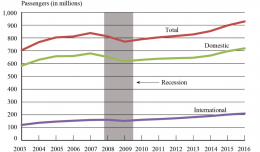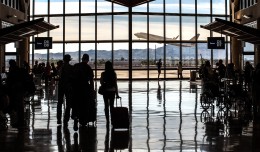(Editors Note: Part 1 of this article, published last week, discussed turbulence at cruise altitude. Part 2 focuses on wake turbulence”)
There’s also something known as “wake turbulence.” This is a different phenomenon…
If you can picture the cleaved roil of water that trails behind a boat or ship, you’ve got the right idea. With aircraft, this effect is exacerbated by a pair of vortices that spin from the wingtips. At the wings’ outermost extremities, the higher-pressure air beneath is drawn toward the lower pressure air on top, resulting in a tight, circular flow that trails behind the aircraft like a pronged pair of sideways tornadoes. The vortices are most pronounced when a plane is slow and the wings are working hardest to produce lift. Thus, prime time for an encountering them is during approach or departure. As they rotate—at speeds that can top 300 feet per second—they begin to diverge and sink. If you live near an airport, stake out a spot close to a runway and listen carefully as the planes pass overhead; you can often hear the vortices’ whip-like percussions as they drift toward the ground.
As a rule, bigger planes brew up bigger, most virulent wakes, and smaller planes are more vulnerable should they run into one. The worst offender is the Boeing 757. A mid-sized jet, the 757 isn’t nearly the size of a 747 or 777, but thanks to a nasty aerodynamic quirk it produces an outsized wake that, according to one study, is the most powerful of any airplane.
To avoid wake upsets, air traffic controllers are required to put extra spacing between large and small planes. For pilots, one technique is to slightly alter the approach or climb gradient, remaining above any vortices as they sink. Another trick is to use the wind. Gusts and choppy air will break up vortices or otherwise move them to one side. Winglets — those upturned fins at the end of the wings — also are a factor. One of the ways these devices increase aerodynamic efficiency is by mitigating the severity of wingtip vortices. Thus a winglet-equipped plane tends to produce a more docile wake than a similarly sized plane without them.
Despite all the safeguards, at one time or another, every pilot has had a run-in with wake, be it the short bump-and-roll of a dying vortex or a full-force wrestling match. Such an encounter might last only a few seconds, but they can be memorable. For me, it happened in Philadelphia in 1994.
Ours was a long, lazy, straight-in approach to runway 27R from the east, our nineteen-seater packed to the gills. Traffic was light, the radio mostly quiet. At five miles out, we were cleared to land. The traffic we’d been following, a 757, had already cleared the runway and was taxiing toward the terminal. We’d been given our extra ATC spacing buffer, and just to be safe, we were keeping a tad high on the glide path. Our checklists were complete, and everything was normal.
At around 200 feet, only seconds from touchdown, with the approach light stanchions below and the fat white stripes of the threshold just ahead, came a quick and unusual nudge—as if we’d struck a pothole. Then, less than a second later, came the rest of it. Almost instantaneously, our 16,000-pound aircraft was up on one wing, in a 45-degree right bank.
It was the first officer’s leg to fly, but suddenly there were four hands on the yokes, turning to the left as hard as we could. Even with full opposite aileron—something never used in normal commercial flying—the ship kept rolling to the right. There we were, hanging sideways in the sky; everything in our power was telling the plane to go one way, and it insisted on going the other. A feeling of helplessness, of lack of control, is part and parcel of nervous flyer psychology. It’s an especially bad day when the pilots are experiencing the same uncertainty.
Then, as suddenly as it started, the madness stopped. In less than five seconds, before either of us could utter so much as an expletive, the plane came to its senses and rolled level.
If you’re interested, it’s possible to stake out a spot near and airport and actually hear wingtip vortices as they drift toward the ground:
You need to be very close to a runway — preferably within a half-mile of the end. The strongest vortices are produced on takeoff, but ideally you want to be on the landing side, as the plane will be nearer (i.e. lower) at an equivalent position from the threshold. A calm day is ideal, as wind will dissipate a vortex before it reaches the ground. About 30 seconds after the jet passes overhead you’ll begin to hear a whooshing, crackling and thundering. It’s a menacing sound unlike anything you’ve heard before. See — or hear — for yourself in this footage captured on my iPhone.
It was taken at the Belle Isle Marsh Reservation, a popular birdwatching spot about a half-mile north of runway 22R at Boston’s Logan International Airport. The plane is a 757. Excuse the atrocious video quality, but the sound is acceptable and that’s the important thing. You begin to hear the vortices at time 0:45, and they continue pretty much to the end. Note the incredible gunshot-like noises at 0:58.
Play loud!
This article was originally published on AskThePilot.com and is used here with the author’s permission. Patrick Smith is an airline pilot, author, and host of AskThePilot.com. His new book is COCKPIT CONFIDENTIAL: Everything You Need to Know About Air Travel. He lives in Somerville, Massachusetts.







